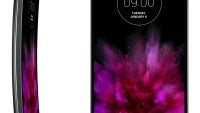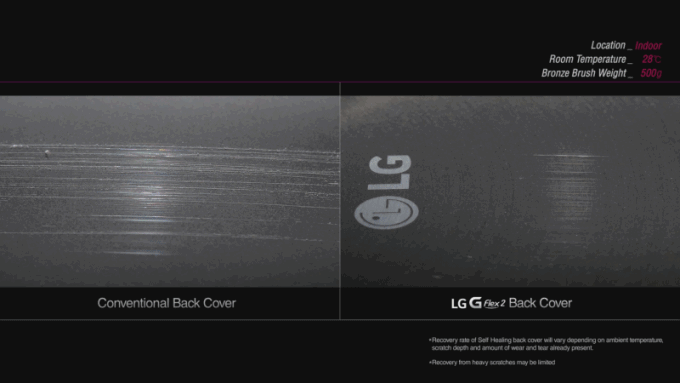The LG G Flex 2 revealed - its curves are dynamic, its CPU is the Qualcomm Snapdragon 810, and its back heals itself

Hey, we told you the LG G Flex 2 is coming to CES 2015, right? It sure did! The G Flex 2 is officially official, looking every bit as the leaks and renders imagined it. Not only that, but LG's curvy handset will be remembered as the one that kick-started the wave of Qualcomm Snapdragon 810-powered superphones. As if that's not enough, the original G Flex's self-healing back panel coating is back with an enormous speed upgrade, while the curved display's glass coating has been strengthened with a chemical cocktail prepared by LG itself. And there's more where that came from!
The LG G Flex 2 is looking every bit as flexed as those leaked renders and images had us imagine. It's also the first known smartphone to have the fresh out of the oven Qualcomm Snapdragon 810 64-bit processor at the base of its operations. As if that's not enough to make the G Flex 2 special, the original G Flex's self-healing back panel wizardry makes a triumphant comeback. Design-wise, the Android 5.0-powered handset combines the LG G3's simple, practical style with the G Flex's dynamic curves.
But if you're left unimpressed and keep asking yourselves why LG made a banana-shaped phone, the answers we're given are pretty convincing. The short answer is that LG, a renowned panel supplier, needs to bring its curved display technology to the market in some shape and form. The long answer is that, plus the ergonomic gains. The banana shape brings the handset's microphone closer to your lips and makes it feel nicer to grip and hold against your ear.
However, we have our doubts on whether the G Flex 2 is sufficiently pocket-friendly. We'll see about that when we're finished gazing at its 5.5-inch 1080p display - both more reasonably sized, and with higher resolution and pixel density than the original's 6-inch, 720p panel. The technology at play is, once again, LG's plastic OLED as seen in the LG G Watch R. While the P-OLED panel appeared totally "naked" on LG's circular smart-watch, the one on the LG G Flex 2 is covered with glass that's been given a special treatment by LG's chemists, resulting in a 20% improvement in toughness. And while we're talking special materials, the self-healing back we mentioned has seen a dramatic boost in speed. The one on the original G Flex took about three minutes to heal, while this one restores itself in 10 seconds at room temperature. Check out the process below:

In addition, LG introduces three new gesture controls. Gesture shot, the LG G3's charming selfie-taking hand gesture, makes a comeback. Gesture View is an easy move for checking the last photo immediately after taking it. And Glance View shows the time, recent messages, missed calls and notifications on the display by swiping down on it while it's off. This must be LG's interpretation of the Nexus 6's ambient notifications feature.
Speaking of photos, the camera sees an improvement as well. The LG G Flex 2 is outfitted with a 13MP OIS cam with laser auto-focus. We can't know for sure whether is the same unit as the one in the LG G3, but having seen a similar configuration perform in it, the G Flex 2's cam promises really nice photos taken in a split-second. The front camera, meanwhile, is just a 2.1MP unit, which is below average in the age of selfie-phones.
A smartphone that flexes some serious muscle!
Speaking of photos, the camera sees an improvement as well. The LG G Flex 2 is outfitted with a 13MP OIS cam with laser auto-focus. We can't know for sure whether is the same unit as the one in the LG G3, but having seen a similar configuration perform in it, the G Flex 2's cam promises really nice photos taken in a split-second. The front camera, meanwhile, is just a 2.1MP unit, which is below average in the age of selfie-phones.
And while we're on the topic of hardware, let's give the G Flex 2's innards a more detailed examination. The handset runs on Qualcomm's Snapdragon 810 processor, a 2.0GHz 64-bit octa-core monster of a CPU. It is paired with 2GB of fast DDR4 RAM - it looks like LG is in no hurry to push for 4GB of RAM right now. There are 16 or 32GB of expandable on-board storage. The battery unit is of 3000mAh capacity with fast charge support (charges to 50% in 40 minutes).
Connectivity wise, the G Flex 2 offers 4G / LTE / HSPA+ 21/42 Mbps, Wi-Fi 802.11 a/b/g/n/ac, Bluetooth Smart Ready (Apt-X) 4.1, NFC, SlimPort, A-GPS / Glonass, and USB 2.0.
All of this fits into a package sized 5.87 x 2.96 x 0.27in (at the thinnest spot) - 0.37 (at the thickest spot) (149.1 x 75.3 x 7.1 - 9.4mm).
The LG G Flex 2 will be hitting the South Korean market in the end of January, with a global launch set to follow soon after. It will be available in Platinum Silver and Flamenco Red. All in all, we're looking at a smartphone that flexes some serious muscle, while filling in as a spectacular appetizer for the upcoming LG G4. Your move, Samsung!
source: LG
EVOLUTION OF LG’s CURVED
SMARTPHONE UNVEILED AT CES 2015
LG G Flex2 Features Dynamically Curved Design Optimized
with Sharper Display, Powerful Hardware, Intuitive Software
LAS VEGAS, Jan. 5, 2015 — LG Electronics (LG) continues to push the industry boundaries with the unveiling of the new G Flex2 at the 2015 International CES® in Las Vegas. The original G Flex earned positive reviews for its innovative design and outside-the-box thinking. One year later, the G Flex2 improves upon its predecessor in every way possible with a more advanced design, faster performance and most importantly, greater convenience.
The LG G Flex2 boasts sleeker, more stylish curves and a powerful Qualcomm® Snapdragon™ 810 processor with octa-core 64-bit capable CPUs for a nimbler and smoother performance. Its 5.5-inch display gets a bump up to Full HD, while the updated software offers even more conveniences through all-new features such as Gesture View and Glance View. The unique “Self Healing” back cover from the original G Flex carries over to the G Flex2 and is now faster and more effective than before.
Beauty In The Details
The G Flex2 goes beyond its predecessor’s groundbreaking 700mm radius curved profile. The new smartphone harmoniously incorporates a symphony of curves ranging from a radius of 400mm to 700mm across the front, back, sides and top-to-bottom edges. The dynamically curved layers deliver a sleeker and more dynamic look to G Flex2.
However, the G Flex2’s curves are for more than looks. The phone’s ergonomic design brings the microphone closer to the mouth, for better sound pickup compared to conventional smartphones which allow much more outside noise to enter the phone through the microphone. The slimmed down 5.5 inches screen with curvatures makes the perfect fit for eyes and the grip. The display’s 700mm radius curvature delivers a truly immersive viewing experience from any angle, while the steeper 650mm radius curvature of the back is more comfortable to grip and fits easier in the pocket. The display’s resolution has also been bumped up to 1080p Full HD, which makes every UI detail appear crisp and alive. The P-OLED display, which gives the G Flex2 its unique shape and durability, is even more precise than in the original G Flex.
Turning the phone over reveals handcrafted details such as the Spin Hairline Pattern on the G Flex2’s curved rear, which showcases the subtle yet brilliant polish of the surface from every angle.
Most Advanced Technology To Date
The G Flex2 is the first smartphone officially announced to come equipped with the Snapdragon 810 processor, featuring octa-core 64-bit capable CPUs optimized for Android 5.0 and the advanced Qualcomm® Adreno™ 430 GPU for stunning graphics performance. This makes the smartphone incredibly fast and efficient for multimedia and multi-tasking. The Snapdragon 810 also features fully integrated 3x20MHz Carrier Aggregation support for faster, more efficient connectivity.
What’s more, the G Flex2’s cover glass is approximately 20 percent more durable, thanks to a special chemical treatment technology developed by LG.
The Self Healing back, which keeps the phone looking new even through the nicks and scratches from normal everyday use, has also been improved with significantly faster healing time. LG reduced the healing time from about three minutes to just within ten seconds at room temperature.
Another innovative technology only available in LG smartphones is the amazingly fast Laser Auto Focus camera, first introduced in the popular LG G3. This technology enables the G Flex2 to capture the best moment — even in low light — by measuring the distance between the subject and the camera using a laser beam. Combined with LG’s proven OIS+ technology and dual LED flash, the G Flex2 delivers images that rival most standalone point and shoot cameras.
Practical Solutions for User Convenience
The G Flex2’s curve-enhanced user experience carries over to software as well. It comes fully loaded with the best of LG’s unique software features optimized for its curved form factor:
Gesture Shot makes it easy to capture the perfect selfie with a simple hand gesture recognizable from up to 1.5 meters away.
Gesture View makes it easy to check your last shot immediately after taking a photo or selfie.
Glance View displays key information such as time, recent messages or missed calls with a downward swipe of the curved screen even while the display is off.
Fast Charge allows the embedded 3,000mAh battery in the G Flex2 — the only curved mobile battery in the world to be charged up to 50 percent in under 40 minutes.
“The original G Flex demonstrated LG’s pioneering spirit and with the G Flex2 we have refined the curved form factor, staying true to our philosophy of innovation for a better life,” said Juno Cho, president and CEO of the LG Electronics Mobile Communications Company. “The G Flex2 not only has the stunning looks, it also has the powerful guts to be at the cutting edge of current smartphone technology. Simply put, it’s a true head-turner in every sense of the word.”
The LG G Flex2 will be available starting at the end of the month in Korea to be followed by additional global markets. The device will initially be available in two colors: Platinum Silver and Flamenco Red.
Visitors to LG’s booth at CES 2015 (Las Vegas Convention Center, Central Hall #8204) can experience LG’s newest mobile devices, including the G Flex2, for themselves. For more information, visit LG’s online press room at www.LGnewsroom.com/ces2015.
Key Specifications (may vary depending on market):
Chipset: Qualcomm® Snapdragon™ 810 processor with 2.0GHz 64-bit Octa-Core CPU
Display: 5.5-inch Full HD Curved P-OLED (1080 x 1920 pixels / 403 ppi)
Memory: 16/32MB eMMC ROM / 2GB DDR4 RAM / microSD slot (up to 2TB)
Camera: Rear 13.0MP with OIS+ with Laser Auto Focus / Front 2.1MP
Battery: 3,000mAh (embedded)
Operating System: Android 5.0 Lollipop
Size: 149.1 x 75.3 x 7.1-9.4mm
Weight: 152g
Network: 4G / LTE / HSPA+ 21/42 Mbps
Connectivity: Wi-Fi 802.11 a/b/g/n/ac, Bluetooth Smart Ready (Apt-X) 4.1, NFC,
SlimPort, A-GPS / Glonass, USB 2.0
Color: Platinum Silver, Flamenco Red
Other: Gesture Shot, Gesture View, Glance View etc.
Follow us on Google News


![Some T-Mobile users might be paying more starting in March [UPDATED]](https://m-cdn.phonearena.com/images/article/176781-wide-two_350/Some-T-Mobile-users-might-be-paying-more-starting-in-March-UPDATED.webp)











Things that are NOT allowed:
To help keep our community safe and free from spam, we apply temporary limits to newly created accounts: